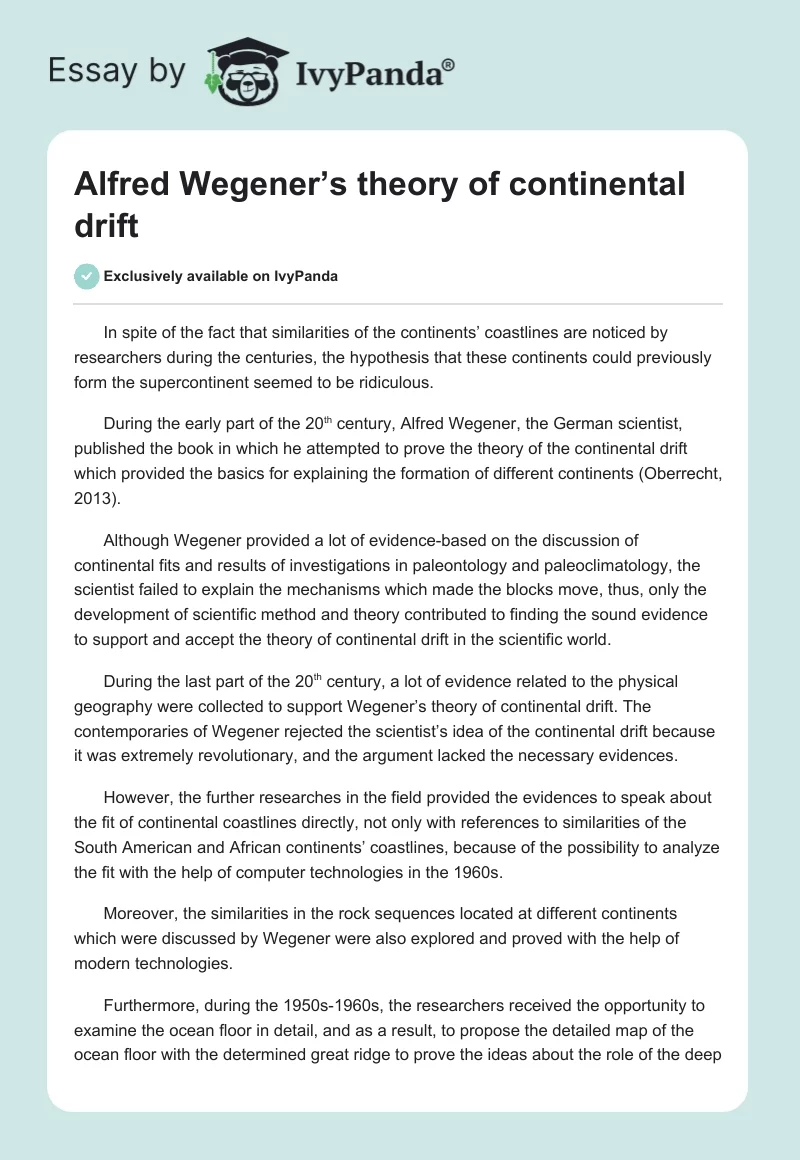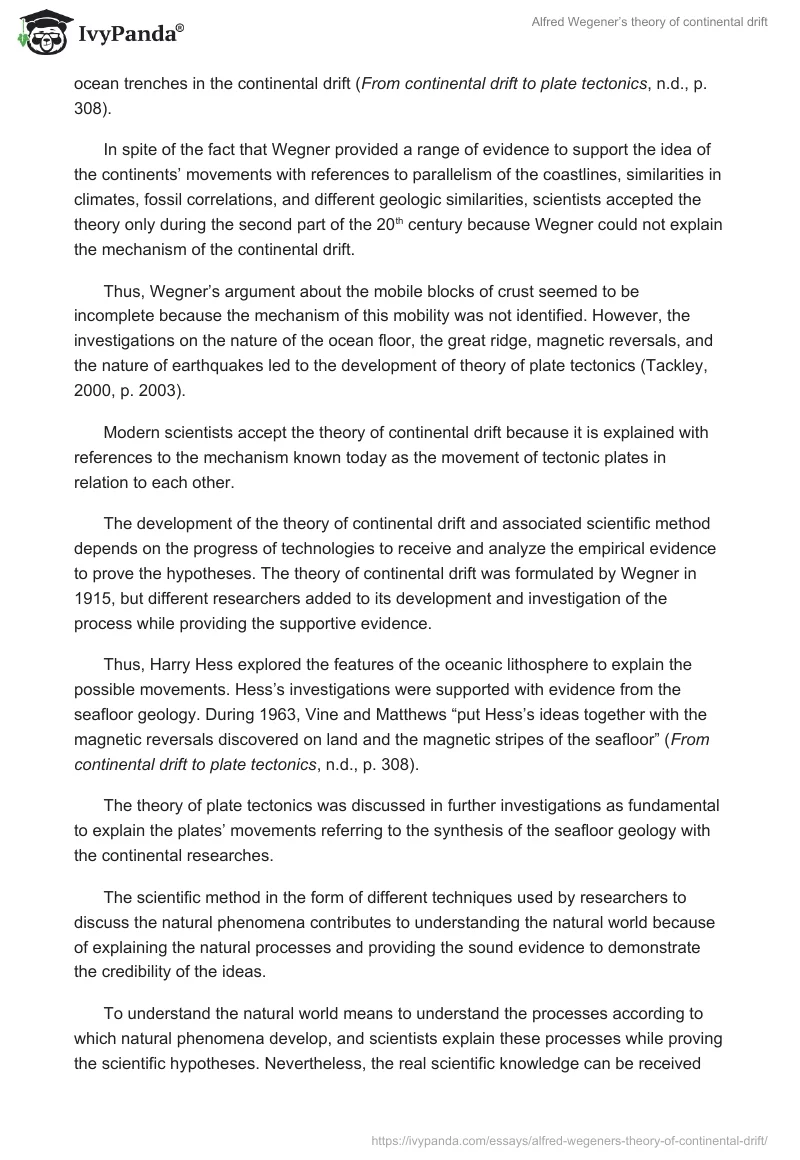In spite of the fact that similarities of the continents’ coastlines are noticed by researchers during the centuries, the hypothesis that these continents could previously form the supercontinent seemed to be ridiculous.
During the early part of the 20th century, Alfred Wegener, the German scientist, published the book in which he attempted to prove the theory of the continental drift which provided the basics for explaining the formation of different continents (Oberrecht, 2013).
Although Wegener provided a lot of evidence-based on the discussion of continental fits and results of investigations in paleontology and paleoclimatology, the scientist failed to explain the mechanisms which made the blocks move, thus, only the development of scientific method and theory contributed to finding the sound evidence to support and accept the theory of continental drift in the scientific world.
During the last part of the 20th century, a lot of evidence related to the physical geography were collected to support Wegener’s theory of continental drift. The contemporaries of Wegener rejected the scientist’s idea of the continental drift because it was extremely revolutionary, and the argument lacked the necessary evidences.
However, the further researches in the field provided the evidences to speak about the fit of continental coastlines directly, not only with references to similarities of the South American and African continents’ coastlines, because of the possibility to analyze the fit with the help of computer technologies in the 1960s.
Moreover, the similarities in the rock sequences located at different continents which were discussed by Wegener were also explored and proved with the help of modern technologies.
Furthermore, during the 1950s-1960s, the researchers received the opportunity to examine the ocean floor in detail, and as a result, to propose the detailed map of the ocean floor with the determined great ridge to prove the ideas about the role of the deep ocean trenches in the continental drift (From continental drift to plate tectonics, n.d., p. 308).
In spite of the fact that Wegner provided a range of evidence to support the idea of the continents’ movements with references to parallelism of the coastlines, similarities in climates, fossil correlations, and different geologic similarities, scientists accepted the theory only during the second part of the 20th century because Wegner could not explain the mechanism of the continental drift.
Thus, Wegner’s argument about the mobile blocks of crust seemed to be incomplete because the mechanism of this mobility was not identified. However, the investigations on the nature of the ocean floor, the great ridge, magnetic reversals, and the nature of earthquakes led to the development of theory of plate tectonics (Tackley, 2000, p. 2003).
Modern scientists accept the theory of continental drift because it is explained with references to the mechanism known today as the movement of tectonic plates in relation to each other.
The development of the theory of continental drift and associated scientific method depends on the progress of technologies to receive and analyze the empirical evidence to prove the hypotheses. The theory of continental drift was formulated by Wegner in 1915, but different researchers added to its development and investigation of the process while providing the supportive evidence.
Thus, Harry Hess explored the features of the oceanic lithosphere to explain the possible movements. Hess’s investigations were supported with evidence from the seafloor geology. During 1963, Vine and Matthews “put Hess’s ideas together with the magnetic reversals discovered on land and the magnetic stripes of the seafloor” (From continental drift to plate tectonics, n.d., p. 308).
The theory of plate tectonics was discussed in further investigations as fundamental to explain the plates’ movements referring to the synthesis of the seafloor geology with the continental researches.
The scientific method in the form of different techniques used by researchers to discuss the natural phenomena contributes to understanding the natural world because of explaining the natural processes and providing the sound evidence to demonstrate the credibility of the ideas.
To understand the natural world means to understand the processes according to which natural phenomena develop, and scientists explain these processes while proving the scientific hypotheses. Nevertheless, the real scientific knowledge can be received only with the help of experiments or proper scientific exploration (Yi & Oldroyd, 1989, p. 22).
The understanding of the natural phenomenon depends on the researchers’ findings received as a result of different types of theoretical and empirical investigations, as it is observed with references to examining the continental drift.
The theory of continental drift became widely discussed as credible after the theory of plate tectonics provided the mechanism for it. According to the plate tectonics theory, the blocks of crust can move in relation to each other because of the impact of structural trends, deep ocean trenches, magnetism, the movements associated with the ocean ridge’s central rift (Mayhew, 2013, p. 141; Stein, 1999).
Thus, the lithosphere is fragmented because of the different geological or physical processes, and these processes also led to the continental drift.
From this perspective, the plate tectonics also explains the definite process of continental drift. Referring to the fundamentals of the crust and plates’ formation, the theory explains the processes of plates’ destruction and movements as a result of the geological processes (The theory of plate tectonics, 2013).
In this case, the explanation of the continental drift is based on the same key aspects as the explanation of such processes as volcanism or seismicity (Shipley, 2003, p. 487).
In addition, the plate tectonics also explains such natural landforms as the Himalayas and the Ring of Fire in the Pacific Ocean. Following the theory, rock sequences are formed at the place of the plates’ collision. Thus, the Himalayas are formed at the place of the Indo-Australian and Eurasian Plates’ collision.
The occurrence of earthquakes and volcanoes also depends on the theory of plate tectonics and on the specifics of the plates’ location and possible collision.
From this point, the Ring of Fire in the Pacific Ocean is the territory where many active volcanoes are located and where frequent earthquakes are observed. The moving plates can cause the significant earthquakes and following destructions because a lot of the energy is released (Dietz, 1983).
Alfred Wegener’s theory of continental drift was discussed as ridiculous and revolutionary during the early part of the 20th century, but later it was proved because of the efforts of the scientists interested in the question.
The developed theory of plate tectonics was effective to explain the mechanism of the continental drift, thus, many controversial questions were resolved with references to the developed scientific method and different approaches used by the scientists to find the answers to the problematic questions.
References
Dietz, R. (1983). In defense of drift. Sciences, 23(6), 22-26. From continental drift to plate tectonics: The evidence. (n.d.). Web.
Mayhew, R. (2013). Research resource review: The Continental Drift Controversy (four volumes). Progress in Physical Geography, 37(1), 140-147.
Oberrecht, K. (2013). The theory of continental drift. Web.
Shipley, B. (2003). Plate tectonics: An insider’s history of the modern theory of the Earth. British Journal for the History of Science, 36(131), 487-488.
Stein, D. (1999). The rejection of Continental Drift: Theory and method in American earth science. American Scientist, 87(5), 467-468.
Tackley, P. (2000). Mantle convection and plate tectonics: Toward an integrated physical and chemical theory. Science, 288(5473), 2002-2007.
The theory of plate tectonics. (2013). Web.
Yi, Y., & Oldroyd, D. (1989). The introduction and development of Continental Drift Theory and Plate Tectonics in China: a case study in the transference of scientific ideas from West to East. Annals of Science, 46(1), 21-34.


